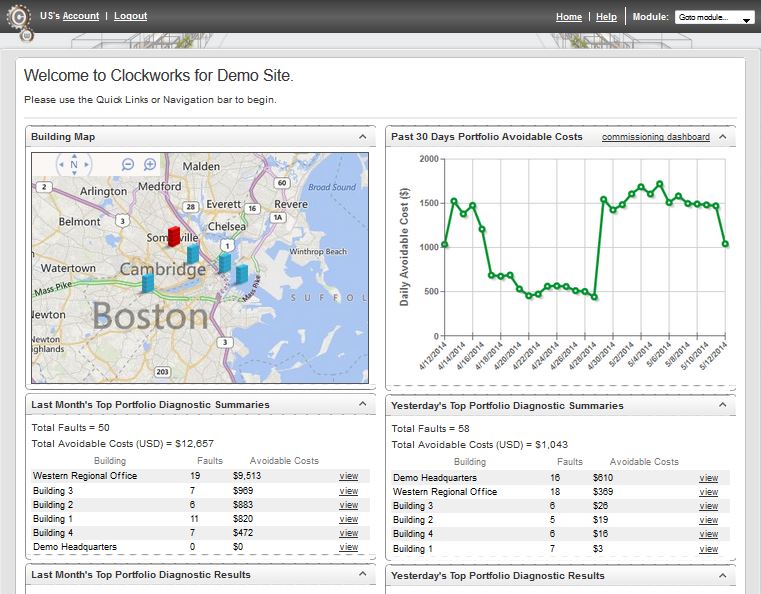"devices" entries

Smarter buildings through data tracking
Buildings are ready to be smart — we just need to collect and monitor the data.
Buildings, like people, can benefit from lessons built up over time. Just as Amazon.com recommends books based on purchasing patterns or doctors recommend behavior change based on what they’ve learned by tracking thousands of people, a service such as Clockworks from KGS Buildings can figure out that a boiler is about to fail based on patterns built up through decades of data.
I had the chance to be enlightened about intelligent buildings through a conversation with Nicholas Gayeski, cofounder of KGS Buildings, and Mark Pacelle, an engineer with experience in building controls who has written for O’Reilly about the Internet of Things. Read more…

Business models that make the Internet of Things feasible
The bid for widespread home use may drive technical improvements.
For some people, it’s too early to plan mass consumerization of the Internet of Things. Developers are contentedly tinkering with Arduinos and clip cables, demonstrating cool one-off applications. We know that home automation can save energy, keep the elderly and disabled independent, and make life better for a lot of people. But no one seems sure how to realize this goal, outside of security systems and a few high-end items for luxury markets (like the Nest devices, now being integrated into Google’s grand plan).
But what if the willful creation of a mass consumer market could make the technology even better? Perhaps the Internet of Things needs a consumer focus to achieve its potential. This view was illuminated for me through a couple recent talks with Mike Harris, CEO of the home automation software platform Zonoff.

Advances in health IT must be viewed as a whole
New report ties together devices, data, records, and aspects of care.
Reformers in health care claim gigantic disruption on the horizon: devices that track our movements, new treatments through massive data crunching, fluid electronic records that reflect the patient’s status wherever she goes, and even the end of the doctor’s role. But predictions in the area of health IT are singularly detached from the realities of the technical environment that are supposed to make them happen.
To help technologists, clinicians, and the rest of us judge the state of health IT, I’ve released a report titled “The Information Technology Fix for Health: Barriers and Pathways to the Use of Information Technology for Better Health Care.” It offers an overview of each area of innovation to see what’s really happening and what we need to make it progress further and faster.

Defining the industrial Internet
Some broad thoughts on characteristics that define the industrial Internet field.
We’ve been collecting threads on what the industrial Internet means since last fall. More case studies, company profiles and interviews will follow, but here’s how I’m thinking about the framework of the industrial Internet concept. This will undoubtedly continue to evolve as I hear from more people who work in the area and from our brilliant readers.
The crucial feature of the industrial Internet is that it installs intelligence above the level of individual machines — enabling remote control, optimization at the level of the entire system, and sophisticated machine-learning algorithms that can work extremely accurately because they take into account vast quantities of data generated by large systems of machines as well as the external context of every individual machine. Additionally, it can link systems together end-to-end — for instance, integrating railroad routing systems with retailer inventory systems in order to anticipate deliveries accurately.
In other words, it’ll look a lot like the Internet — bringing industry into a new era of what my colleague Roger Magoulas calls “promiscuous connectivity.” Read more…

Why I can't shake my ereader
Battery life and device weight keep E Ink devices on wish lists.
Ereaders are now commodities — improvements are incremental at best — but the fundamental qualities of these devices still make them compelling.

Editorial Radar with Mike Loukides & Mike Hendrickson
Discussion on machine learning, 3D printing, devices and JavaScript
In this first episode of "Editorial Radar," O'Reilly editors Mike Loukides and Mike Hendrickson discuss the important technologies they're tracking.

It's time for a unified ebook format and the end of DRM
Proprietary ebook formats and rights restrictions are holding consumers back.
The music industry has shown that you need to offer consumers a universal format and content without rights restrictions. So when will publishers pay attention?

Don't expect the end of electronics obsolescence anytime soon
Software updates can't rejuvenate old hardware.
Software updates for consumer electronics sound great in theory. But over time, the discrepancy between what the software is supposed to do and what your devices are capable of will rub obsolescence in your face.

A study confirms what we've all sensed: Readers are embracing ereading
BISG's Angela Bole on results from the "Consumer Attitudes Toward E-Book Reading" study.
In this interview, Angela Bole of the Book Industry Study Group reviews results from the "Consumer Attitudes Toward E-Book Reading" study. She says the data looks good for publishers, assuming they can develop the right business models.

